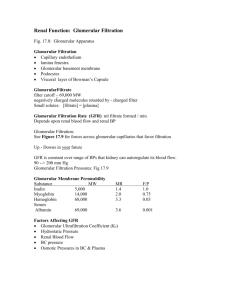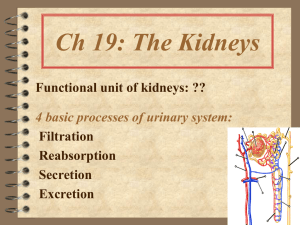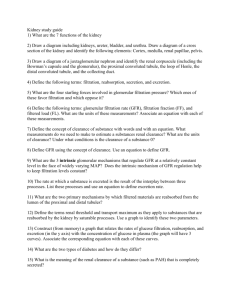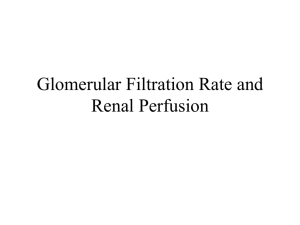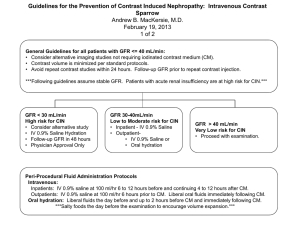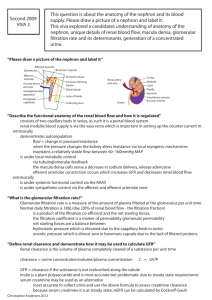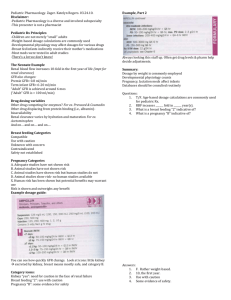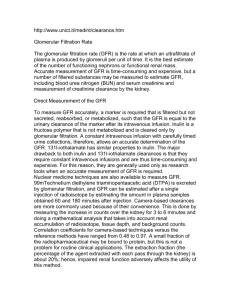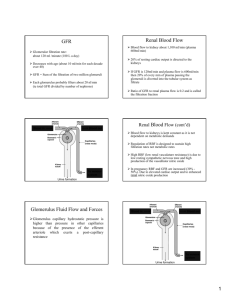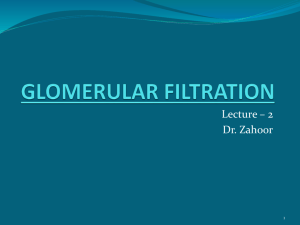GLOMERULAR FILTRATION RATE (GFR)
advertisement
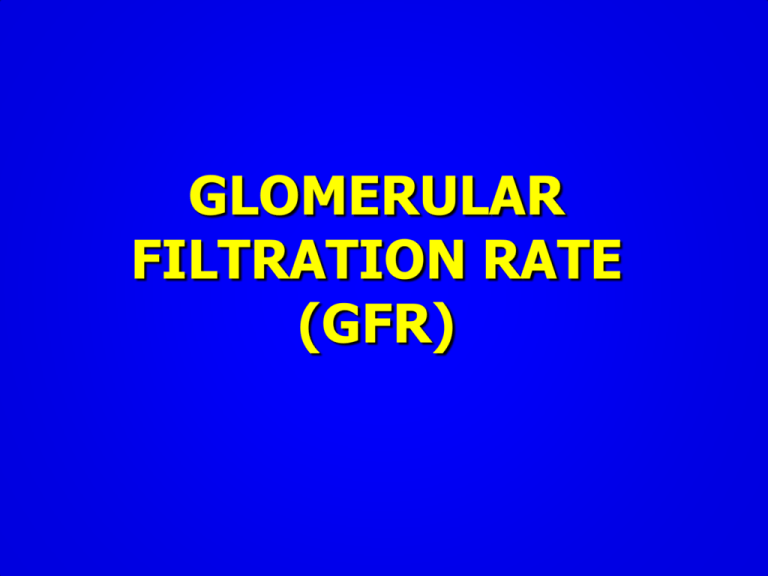
GLOMERULAR FILTRATION RATE (GFR) Glomerular filtration rate (GFR) Definition: Is the volume of plasma filtered by all nephrons in both kidneys/unit time = 125ml/min GFR values = 180L/day Varies with kidney size and lean body weight Less in women Variation in GFR between different species depend on number of nephrons GFR 125 ml/min (180L/day) (about 1% is excreted) GLOMERULAR FILTRATION Depends on: 1- Pressure gradient across the filtration barrier (endothelium, basal membrane, epithelium = podocytes) 2- Blood circulation throughout the kidneys 3- Permeability of the filtration barrier 4- Filtration membrane surface area The solution after filtration is very similar to plasma, but should be WITHOUT PROTEIN Nephron Glomerular Filtration Forces Blood hydrostatic pressure (PH) Outward filtration pressure of 55 mm Hg Constant across capillaries due to restricted outflow (efferent arteriole is smaller in diameter than the afferent arteriole) Colloid osmotic pressure (π) • Opposes hydrostatic pressure at 30 mm Hg • Due to presence of proteins in plasma, but not in glomerular capsule (Bowman’s capsule) Capsular hydrostatic pressure (Pfluid) • Opposes hydrostatic pressure at 15 mm Hg 1 GLOMERULAR BLOOD HYDROSTATIC PRESSURE (GBHP) = 55 mmHg 2 CAPSULAR HYDROSTATIC PRESSURE (CHP) = 15 mmHg 3 BLOOD COLLOID OSMOTIC PRESSURE (BCOP) = 30 mmHg Afferent arteriole Proximal convoluted tubule Efferent arteriole NET FILTRATION PRESSURE (NFP) =GBHP – CHP – BCOP = 55 mmHg 15 mmHg 30 mmHg = 10 mmHg Glomerular (Bowman's) Capsular capsule space Nephron Glomerular Filtration 10 mm Hg of filtration pressure. Is not high, but has a large surface area and nature of filtration membrane. Creates a glomerular filtration rate (GFR) of 125 ml/min which equates to a fluid volume of 180L/day entering the glomerular capsule. • Plasma volume is filtered 60 times/day or 2 ½ times per hour • Requires that most of the filtrate must be reabsorbed, or we would be out of plasma in 24 minutes! Factors affecting GFR 1- Changes in renal blood flow 2- Changes in glomerular capillary hydrostatic pressure Changes in systemic blood pressure Afferent or efferent arteriolar constriction 3- Changes in hydrostatic pressure in Bowman’s capsule: Ureteral obstruction Edema of kidney inside tight renal capsule 4- Changes in concentration of plasma proteins: dehydration, hypoproteinemia, etc (minor factors) 5- Changes in glomerular capillary permeability 6- Changes in effective filtration surface area Three processes controlling GFR Auto regulation (myogenic) Hormonal regulation (tubuloglomerular & renin-angiotensin) Autonomic regulation (extrinsic) Autoregulation of GFR • Changes diameters of afferent, efferent arteriole, and glomerular capillaries – Decrease pressure results in dilation of afferent arteriole, dilation of glomerular capillaries and constriction of efferent arteriole →↑ GFR – Increase pressure results in constriction of afferent arteriole → ↓ GFR Nephron Glomerular Filtration Hormonal Regulation of GFR a) Macula Densa Involves macula densa cells of juxtaglomerular apparatus. Low filtrate and low osmolality Macula densa promotes vasodilation of afferent arteriole, promotes ↑ net filteration pressure and ↑ GFR. High filtrate and high osmolality Macula densa promotes vasoconstriction of afferent arteriole, promotes ↓ net filteration pressure and ↓ GFR. Nephron Regulation of GFR The cells of the macula densa monitor NaCl concentration in the fluid moving into the dital convoluted tubule. If GFR increases, then NaCl movement also increases as a result. Macula densa cells send a paracrine message causing the afferent arteriole to contract, decreasing GFR and NaCl movement. Hormonal Regulation of GFR b) Renin system Decrease in blood pressure and decrease in osmolality in the DCT causes release of renin. The effects of renin include: Vasoconstriction of systemic circulation Constriction of efferent arteriole Promote release of aldosterone Autonomic Regulation of GFR Sympathetic nervous system causes constriction of afferent arteriole which decreases GFR Agents causing contraction or relaxation of mesangial cells Contraction Relaxation Endothelins Angiotensin II Vasopressin Norepinephrine Platelet-activating factor Platelet-derived growth factor Thromboxane A2 PGF2 Leukotrienes C4 and D4 Histamine ANP Dopamine PGE2 cAMP Measurement of GFR The substance used should be: Freely filtered (not reabsorbed or secreted) Not metabolized by the kidney Not toxic and stable Not bound to plasma proteins Does not change renal plasma flow Inulin is the substance. Measurement of GFR cont. Test procedure Intravenous loading dose of inulin followed by intravenous infusion of inulin to maintain plasma level constant. Urine is collected for 15 or 20 min, to measure inulin concentration in urine and urine volume. Blood sample is taken half way of urine collection to measure inulin concentration. Calculation of GFR The amount of inulin excreted = Uin x Uv The amount of inulin filtered = Pin x GFR As inulin is not reabsorbed or excreted both quantities are equal Pin x GFR = Uin x Uv GFR = Uin x Uv = ml/min Pin Filtration fraction GFR / RPF 125 / 650 = 0.19 = 16-20%
